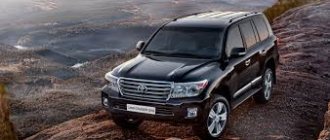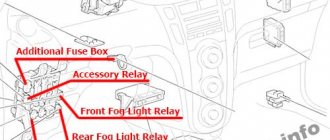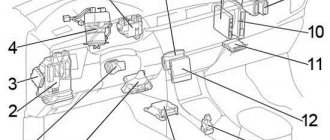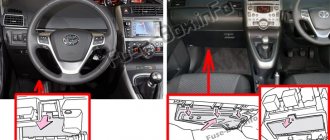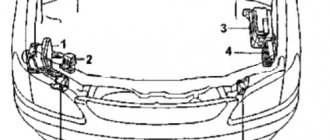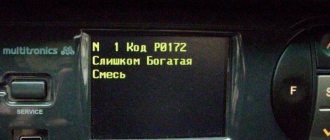Recently, diesel Toyota owners often ask me: what does the PWR HEAT button do? It's too long to describe. Yes, I found it written sensibly and accessible. I share it with my readers. maybe it will be useful to someone.
Sometimes the purpose of the “PWR HEAT” button confuses owners of new Toyota cars. Let's try to figure it out...
POWER HEATER is an additional heater powered by a driven viscous heater and designed to increase the efficiency of the standard heater.
The viscous heater is installed on models with diesel engines 1HD-FTE and 1KD-FTV in versions for regions with cold climates - such as Land Cruiser HDJ101, KDJ95, KDJ125, HiLux Surf KDN185, KDN215.
1. Viscous heater
Heat is generated in the heater when the rotor stirs the silicone liquid in it. The rotor is driven through a pulley by a belt from the crankshaft - similar to a conventional air conditioning compressor drive. Heat is transferred from silicone oil to the coolant entering the heater (stove) circuit.
1 - electromagnetic coupling, 2 - housing, 3 - coolant, 4 - silicone fluid, 5 - rotor, 6 - seal.
The viscous heater is turned on using the “PWR HEAT” or “POWER HEATER” button on the instrument panel.
Based on a signal from the electronic engine control unit, the electromagnetic clutch of the heater is activated through the amplifier.
The viscous heater is controlled through an amplifier tightly connected to the engine ECU.
1 — amplifier, 2 — electromagnetic clutch (viscous heater), 3 — engine ECU, 4 — “POWER HEATER” indicator, 5 — switch, 6 — relay for the electromagnetic clutch of the air conditioning compressor, 7 — electromagnetic clutch (air conditioning compressor).
3. Electronic engine control unit
The control unit monitors the crankshaft speed and coolant temperature and turns the heater on/off, sending an ON/OFF signal to the amplifier. The system has several basic principles: - When the engine starts (when the speed is below 550 rpm), the OFF signal is sent to the amplifier. — During engine operation, at a rotation speed above 2500 rpm, the heater is turned off, and after it is reduced to 2000 rpm, it turns on again.
— When the coolant temperature is above 74°C, the heater turns off and turns on when the temperature drops to 69°C.
— When accelerating (from a speed of less than 40 km/h), if the accelerator pedal is pressed 45% or more, the amplifier is turned off for 6 seconds. — If the vehicle speed is less than 3 km/h and the selector is in the “N” or “P” positions, the control unit forcibly increases the idle speed to 1200 rpm.
Evgeniy, Moscow © Legion-Avtodata
In cold climates, some diesel engines do not produce enough heat to heat the cabin. The PWR HEAT button in the Toyota Land Cruiser 200 activates the additional heating function by increasing engine speed at idle.
Viscous heater
Many car owners are interested in what pwr heat is on a Toyota Prado SUV and the role of this function. This device is a pump manufactured by Denso. It mixes a viscous gel through a rotor, which quickly generates heat due to friction.
Coolant (antifreeze) passes through the mechanism, enters the vehicle's heating system and increases the temperature in the cabin.
The clutch mechanism at the front of the viscous heater starts and stops automatically depending on the operation of the temperature sensors. In weather conditions above 5 o C, the clutch stops the functioning of the mechanism. The coolant passing through it stops heating up further.
In winter, when the temperature is below the set value, the clutch starts the device again. Friction begins to generate heat.
The position of the pump depends on the car model. Typically, the pwr heat system in the Toyota Prado 150 is installed at the front of the engine.
“Power Heat” mode on diesel (additional heater)
Many people ask how diesel heats up in winter, isn’t it cold? How quickly the glass thaws, etc.
I'll try to tell you about my experience. Here in St. Petersburg the frosts are rarely more than 26 degrees, so I will write taking into account these temperature conditions.
When cold weather sets in, I turn on the quick warm-up mode using the “Power Heat” button, which is located on the dashboard.
The engine starts running at higher speeds and reaches operating temperature much faster. After a couple of minutes, warm air is already supplied to the glass. Since I go out on the highway almost immediately, at -22 my diesel reaches operating temperature in about 10-12 minutes. That is, in winter I don’t experience any discomfort in terms of cold in the cabin, etc.
Video demonstrating the supply of warm air during the first minute of engine startup.
“POWER HEATER is an additional heater powered by a drive viscous heater and designed to increase the efficiency of the standard “stove”
The viscous heater is installed on models with diesel engines 1HD-FTE and 1KD-FTV in versions for regions with cold climates - such as Land Cruiser HDJ101, KDJ95, KDJ125, HiLux Surf KDN185, KDN215.
1. Viscous heater
Heat is generated in the heater when the rotor stirs the silicone liquid in it. The rotor is driven through a pulley by a belt from the crankshaft - similar to a conventional air conditioning compressor drive. Heat is transferred from silicone oil to the coolant entering the heater (stove) circuit.
The viscous heater is turned on using the “PWR HEAT” or “POWER HEATER” button on the instrument panel.
Based on a signal from the electronic engine control unit, the electromagnetic clutch of the heater is activated through the amplifier.
2. Amplifier
The viscous heater is controlled through an amplifier tightly connected to the engine ECU.
3. Electronic engine control unit
The control unit monitors the crankshaft speed and coolant temperature and turns the heater on/off, sending an ON/OFF signal to the amplifier. The system has several basic principles:
When the engine starts (when the speed is below 550 rpm), the OFF signal is sent to the amplifier.
While the engine is running, at a rotation speed above 2500 rpm, the heater is turned off, and after it is reduced to 2000 rpm, it turns on again.
When the coolant temperature is above 74°C, the heater turns off and turns on when the temperature drops to 69°C.
When accelerating (from speeds less than 40 km/h), if the accelerator pedal is pressed 45% or more, the amplifier is turned off for 6 seconds.
If the vehicle speed is less than 3 km/h and the selector is in the “N” or “P” positions, the control unit forcibly increases the idle speed to 1200 rpm.
https://autodata.ru/st/10_vh/vh.htm
(c) Evgeniy E., Moscow
ECT PWR/MANU modes on TOYOTA vehicles
As the proud owner Toyota RAV4 with the relatively common WIDE BODY package and a 3S-GE the PWR and MANU automatic transmission control buttons on the dashboard.
This is not my first car and, in principle, the purpose of the buttons was not a secret, but it was not possible to find official information. In our Russian-language forums, we mostly managed to find little information and had to turn to English-language forums. So on the RAV4WOLD website we managed to find such information (translated from English with minor changes).
So, the RAV4 is equipped with a 4-speed automatic transmission with standard markings on the mode selector (more about automatic transmission modes): P: Parking mode; R: Reverse mode; N: Neutral position; D: 4th gear (when the O/D OFF icon is lit on the dashboard, gear shifting occurs only up to third); 2: 2nd gear – for quick acceleration from a standstill or engine braking when descending a mountain at low speed; L: 1st gear - mainly for off-roading or when you want to tow someone.
For the most part, for everyday driving, use the D- position and connect additional modes as necessary.
O/D (overdrive): This mode must be constantly on, except for:
1. Climbing a hill, when the transmission constantly switches between 3rd and 4th gears;
2. When descending from a hill and constantly using the brakes, allow your engine to brake;
3. When you are driving on a road where you are constantly accelerating and braking (usually in traffic jams). This will allow you to use the engine-transmission tandem more efficiently and eliminate constant gear changes;
4. When you are driving at low speeds. Automakers previously recommended using O/D ON mode at speeds above 40 km/h.
ECT PWR/MANU MODE (ECT-S PWR/MANU)
ECT PWR
This little button, when pressed, allows you to change gears later than usual.
This allows you to more fully utilize the engine's potential. For example: You are on the highway moving at a speed of 100 km/h and you begin to climb a hill. When you press this button, you will notice that the transmission has switched to a lower gear and your car seems to have received a second wind and began to accelerate with ease. This one is almost like a kick-down mode. This mode is best used on the highway and when climbing steep hills. Someone really often uses it if they want to make someone at a traffic light.
MANU MODE
This mode locks the selected gear and prevents the transmission from up/downshifting.
For example: You are driving at 60 km/h and you have O/D OFF mode (3rd gear), if you press MANU, it will lock 3rd gear and will not reduce the engine speed even if you release the gas pedal.
Combination of modes under different travel conditions:
O/D OFF + PWR OFF + MANU OFF When the engine is not warmed up, descending/ascending on a hill, in a traffic jam or when driving at speeds up to 40 km/h;
O/D ON + PWR OFF + MANU OFF When driving under normal road conditions;
O/D ON + PWR ON + MANU OFF When driving on highways, overtaking;
O/D OFF + PWR ON + MANU OFF When descending steep hills, when there is a large load on the braking system;
O/D OFF + PWR OFF + MANU ON When it is necessary to block a certain transmission (in some cases).
Sometimes the purpose of the “PWR HEAT” button confuses owners of new Toyota cars.
Let's try to figure it out... POWER HEATER is an additional heater, powered by a drive viscous heater and designed to increase the efficiency of the standard “stove”.
The viscous heater is installed on models with diesel engines 1HD-FTE and 1KD-FTV in versions for regions with cold climates - such as Land Cruiser HDJ101, KDJ95, KDJ125, HiLux Surf KDN185, KDN215.
1. Viscous heater
Heat is generated in the heater when the rotor stirs the silicone liquid in it. The rotor is driven through a pulley by a belt from the crankshaft - similar to a conventional air conditioning compressor drive. Heat is transferred from silicone oil to the coolant entering the heater (stove) circuit.
| 1 - electromagnetic coupling, 2 - housing, 3 - coolant, 4 - silicone fluid, 5 - rotor, 6 - seal. |
The viscous heater is turned on using the “PWR HEAT” or “POWER HEATER” button on the instrument panel.
Based on a signal from the electronic engine control unit, the electromagnetic clutch of the heater is activated through the amplifier. 2. Amplifier
The viscous heater is controlled through an amplifier tightly connected to the engine ECU.
| 1 — amplifier, 2 — electromagnetic clutch (viscous heater), 3 — engine ECU, 4 — “POWER HEATER” indicator, 5 — switch, 6 — relay for the electromagnetic clutch of the air conditioning compressor, 7 — electromagnetic clutch (air conditioning compressor). |
3. Electronic engine control unit
The control unit monitors the crankshaft speed and coolant temperature and turns the heater on/off, sending an ON/OFF signal to the amplifier. The system has several basic principles: - When the engine starts (when the speed is below 550 rpm), the OFF signal is sent to the amplifier. — During engine operation, at a rotation speed above 2500 rpm, the heater is turned off, and after it is reduced to 2000 rpm, it turns on again. — When the coolant temperature is above 74°C, the heater turns off and turns on when the temperature drops to 69°C. — When accelerating (from a speed of less than 40 km/h), if the accelerator pedal is pressed 45% or more, the amplifier is turned off for 6 seconds. — If the vehicle speed is less than 3 km/h and the selector is in the “N” or “P” positions, the control unit forcibly increases the idle speed to 1200 rpm.
Evgeniy, Moscow © Legion-Avtodata
Comments and questions can be sent to [email protected]
Power Heat and Fuel Consumption
At low atmospheric temperatures, paraffin crystals begin to form in diesel fuel, making the structure of the liquid gel-like and layered. Suspended fuel particles can stick together the microporous surface of the filter. For a short period of time, fuel stops flowing through the filter into the injection system. Result: the motor loses power and stops.
To understand what the PWR HEAT function is in the Toyota LC 200 SUV and what it is, you should remember that in the cold winter the engine sometimes freezes and does not start. Sometimes adding gasoline and additives helps solve the problem. But then the car owner needs to predict the situation in advance. Special fuel additives can negatively affect the performance of a Toyota vehicle, shortening the engine's life cycle.
Irregular operation of the engine in difficult weather conditions leads to increased fuel consumption. Thanks to the possibility of additional heating of the machine, the engine is protected at any temperature and prevents higher diesel consumption.
